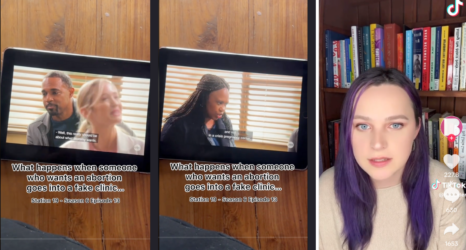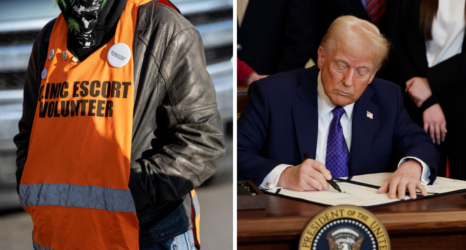Known as the CARES (Coronavirus Aid, Relief, and Economic Security) Act, a $2.2 trillion coronavirus stimulus package was signed into law last week.
The CARES Act is the third piece of major legislation aimed at combatting the effects of the coronavirus—and the most expensive piece of legislation ever passed to date, more than doubling the stimulus act passed in 2009 during the financial crisis.
Broadly speaking, there are five components to the COVID-19 stimulus bill:

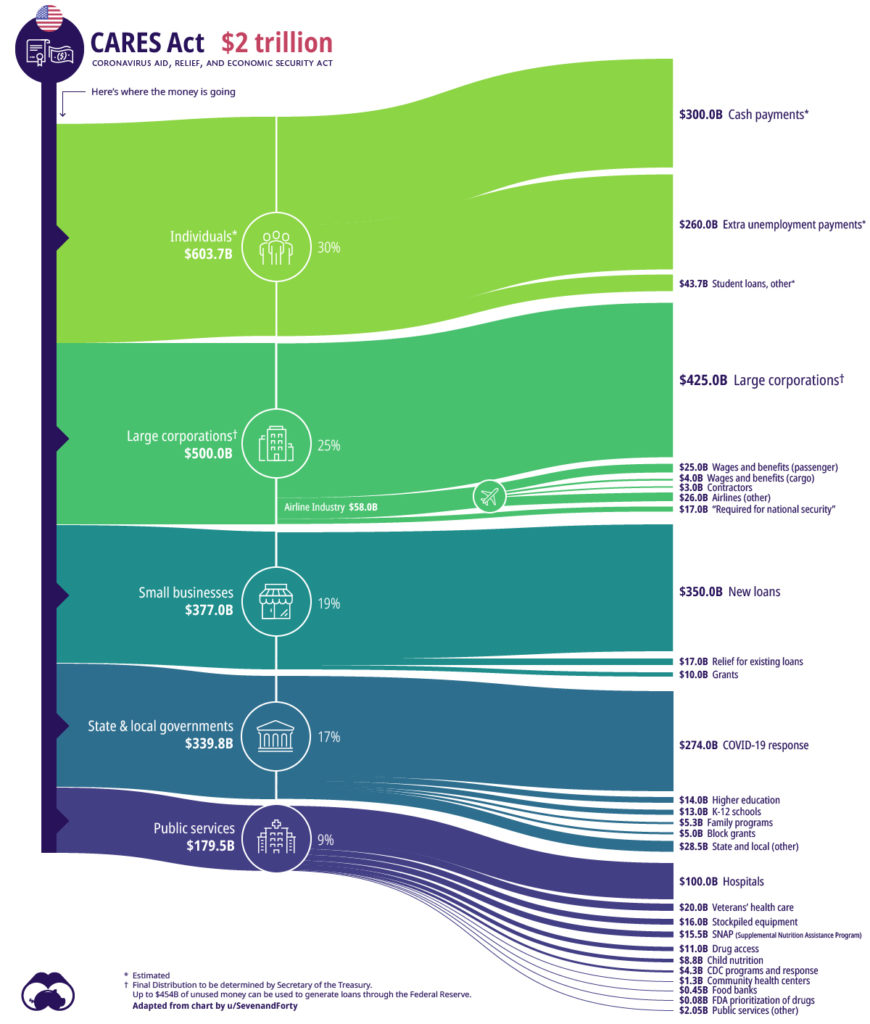
Included: Relief for Individuals, Businesses and States
Individual relief comes in many forms, such as:
- Direct cash payments: Most people earning less than $75,000 can expect a one-time cash payment of $1,200, plus $500 per child.
- A boost to unemployment payments: Unemployment assistance benefits will increase—$600 per week from the federal government on top of whatever base amount a worker receives from the state. The program will also expand who is deemed eligible, like gig workers and freelancers.
- Extension of the tax deadline, from April 15 to July 15.
- Insurance coverage: The bill requires all private insurance plans to cover COVID-19 treatments and vaccine and makes all coronavirus tests free.
Small businesses qualify for grants, loans and loan relief.

Big businesses will see huge relief from this bill—especially the airlines, allotted $58 billion to stay afloat. The money comes with stipulations: no stock buybacks, reporting requirements, and oversight from “a special inspector general to oversee pandemic recovery.”
(Sara Nelson, the president of the Association of Flight Attendants union, calls the bill “an unprecedented win for frontline aviation workers and a template all workers can build from.”
“The payroll grants we won in this bill will save hundreds of thousands of jobs and will keep working people connected to health care many will need during this pandemic,” Nelson added.)
Hospitals and clinics, as well as health initiatives like the CDC and the Strategic National Stockpile, qualify for specific CARES funding in order to meet the influx of new patients.
And social safety net programs that ensure food security—like food stamps, child nutrition programs and food banks—will be bolstered with the new bill.
Missing: The Promise of Ongoing Individual Relief
If the pandemic does in fact last into and even beyond the summer, as some experts predict, a one-time payment of $1,200 is simply not going to cut it.
“We had bigger direct payments in our bill,” House Speaker Nancy Pelosi said Thursday. “I don’t think we’ve seen the end of direct payments.”
The request for additional funding was strengthened this week, as the number of Americans filing for unemployment benefits is forecast to set a record for the second straight week. Last week, 3.3 million in the U.S. had filed for unemployment, and some predict that figure to almost double.
Ultimately, the idea of sending out multiple checks will likely depend in part on how long it takes for the U.S. to contain the outbreak.
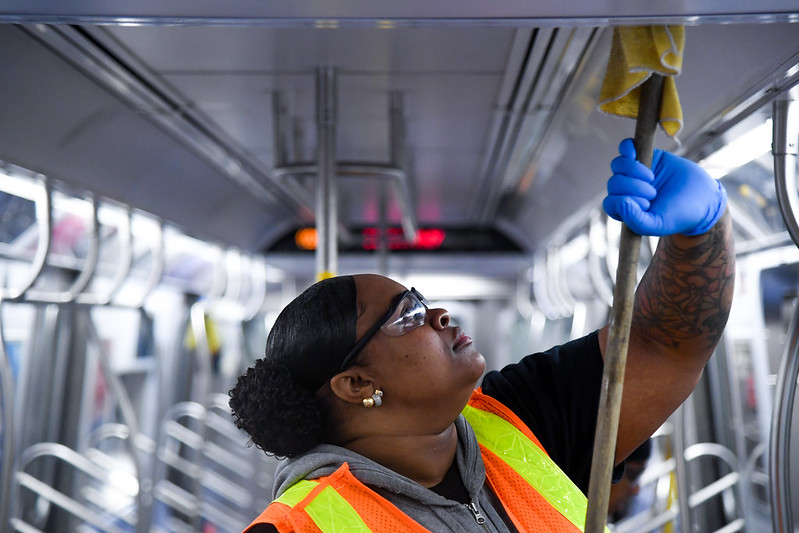
Included: Last-Minute Anti-Abortion Provisions
The CARES Act includes some much-needed health and economic resources—but anti-choice legislators also used the dire nature of this relief bill as an opportunity advance an anti-abortion agenda.
Conditions inside the stimulus bill create new funding hurdles for Planned Parenthood and other abortion clinics that provide health services to the poor.
“It has become shamefully clear that not even a global pandemic will stop the Trump administration or Republican Congressional leaders from attacking access to reproductive care,” said Alexis McGill Johnson, acting president of Planned Parenthood Action Fund.
Missing: Adequate Funding for Schools and Students
From elementary school leaders to university level deans, U.S. schools fear the funding in stimulus bill is largely inadequate.
US News and World Report writes:
THE COUNTRY’S PUBLIC school and higher education systems netted nearly $31 billion combined in the $2 trillion stimulus the House passed Friday to combat the economic repercussions of the coronavirus pandemic—an amount stakeholders say is hardly sufficient to bolster the financial crises they face.
The $30.8 billion education stabilization fund will send $14.3 billion to institutions of higher education, far below the $50 billion college and university officials estimated they’d need to survive the financial hit they’re taking after the majority closed their campuses after spring break and pivoted to distance learning. The country’s K-12 schools will net about $13.5 billion, also a fraction of the $75 billion it had requested to stay afloat as more than 55 million students are out of school.
“As revenues decline and state and local governments’ budgets suffer, Congress must help prevent dramatic cuts from hitting our schools, impacting student services and ensure educators do not lose their jobs,” said Lily Eskelsen García, president of the 3.2 million member National Education Association.
García continued, “The inclusion in this bill of an education stabilization fund was essential—but we know and Congress must understand that tens of billions dollars more will be needed going forward to truly support all students, counter the learning loss happening through school closures and prevent educator layoffs.”
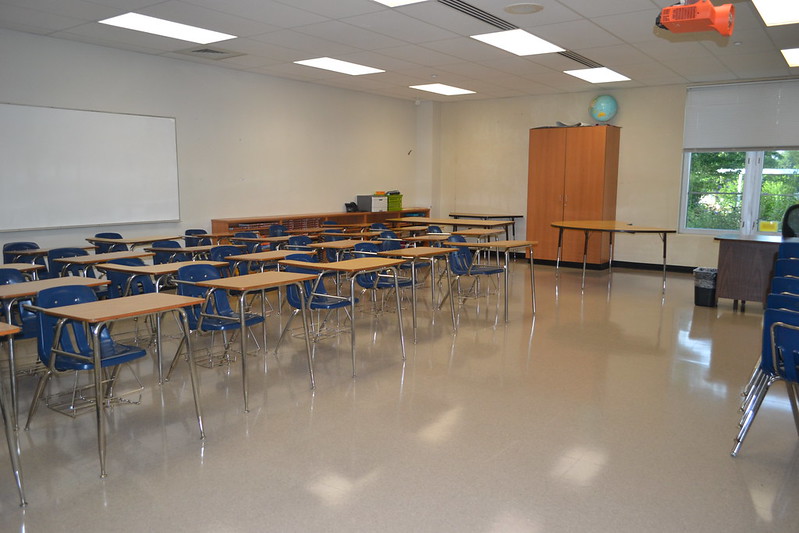
Missing: True Relief from Student Loans
Schools don’t just feel short-changed: So do students and alumni with loans.
The CARES Act stipulates that employers can provide up to $5,250 in tax-free student loan repayment benefits—meaning an employer could contribute to loan payments and workers wouldn’t have to include that money as income.
But that provision assumes that employers have spare cash to spend on employee loans.
Additionally, under the law, people will not have to make payments on federally held student loans until after September 30, and interest on the loans will not accrue during that six-month period. This is a pause; not true relief.
“Today’s coronavirus bill is a life raft—but not a rescue boat—for the millions of young people who are still grappling with how they will make ends meet as they navigate challenges like unemployment, student loan debt, and paying their daily expenses,” Jesse Barba, senior director of external affairs for Young Invincibles, said in a statement.
Considering that women hold two-thirds of the student debt in this country, this burden will fall disproportionately down gendered lines.
Missing: Internet Access for Low-Income Students Learning From Home
Politico Women reports:
The bill most likely won’t address the “homework gap” between those who have reliable internet access and those who don’t. Many had advocated for an FCC program that would help families, schools and libraries connect to the internet, but Republicans and Democrats couldn’t agree on a deal, leaving millions of students at home unable to do their schoolwork online.
Missing: Protections for Those Laid Off Prior to the Bill’s Passage
The proposed coronavirus aid package offers $3 billion in payroll grants to airline contractors, allowing them to continue paying workers.
As part of the bill, companies receiving aid—like airlines— would not be allowed to lay off employees before September 30, 2020.
However, contractors laid off thousands of workers last week—according to officials from the Service Employees International Union (SEIU), which represents many of them. It is unclear if they would be entitled to payroll protections under the coronavirus bailout package. Additionally, contractors would not necessarily be required to rehire workers already laid off due to the outbreak.
Missing: Protections for Disabled Workers
Disabled activists and advocates warn that the stimulus package’s provisions do not do enough for the community—especially since resources for them have been strained by the pandemic.
“There is nothing that the disability community asked for in these bills,” Rebecca Cokley, director of the liberal Center for American Progress’s Disability Justice Initiative, told The Hill.
“This is a classic case of ‘everything about us without us,’ where Congress is making policies that largely ignore the needs of people with disabilities and chronic conditions.”
Missing: Adequate SNAP Funding
As it stands now, the SNAP (nutrition aid) boost proposed by Congressional Democratic leaders was not included in the $2 trillion dollar relief package.
“The bill will help the newly-unemployed, so that’s good, but it’s pretty appalling that it includes hundreds of billions for many big corporations—run by people who make millions of dollars per year, but not a penny more to increase the food allotment for 36 million SNAP recipients, which now equals a paltry $1.34 per meal,” said Joel Berg, CEO of Hunger Free America, a nationwide anti-hunger advocacy and direct service nonprofit organization.
Berg warned that this omission “will both increase hunger and harm grocery stores, farmers markets and corner stores.”
Missing: Election Funding
The League of Women Voters of the United States noted the large stimulus bill lacks adequate funding to safeguard the right to vote in the upcoming November election.
The League of Women Voters CEO Virginia Kase had called for the funding deal to “include a minimum of two billion dollars,” which would go toward the expansion of voting options—”while protecting vulnerable communities and voters who need additional assistance, and to ensure in-person voting can be done in a way that is safe and accessible.”
“Voters must have a variety of options to safely cast their ballot and it is imperative for Congress to fund those measures that will ensure people do not lose their ability to vote during this pandemic,” Kase said.
Missing: Protections for Those Paid in Cash, or Who Don’t File Taxes
The Guardian reports:
But the emergency relief bill still threatens to leave many people out, they said, including domestic workers paid in cash, undocumented workers, homeless Americans, people who do not have bank accounts, and some people who have not filed taxes recently.
In addition, people who do not have direct deposit accounts on file, or who have moved since last filing their taxes, may face delays in getting their emergency payments. Some Americans who have not filed taxes recently may be entirely left out. The Internal Revenue Service estimates that about 30 to 40 million American adults, or about 15% of the population, do not file tax returns, Garrett Watson, an analyst at the conservative Tax Foundation, said.
Pelosi wants to move fast on Phase Four, and possibly vote in the next few weeks.
The coronavirus pandemic and the response by federal, state and local authorities is fast-moving.
During this time, Ms. is keeping a focus on aspects of the crisis—especially as it impacts women and their families—often not reported by mainstream media.
If you found this article helpful, please consider supporting our independent reporting and truth-telling for as little as $5 per month.
You may also like:




